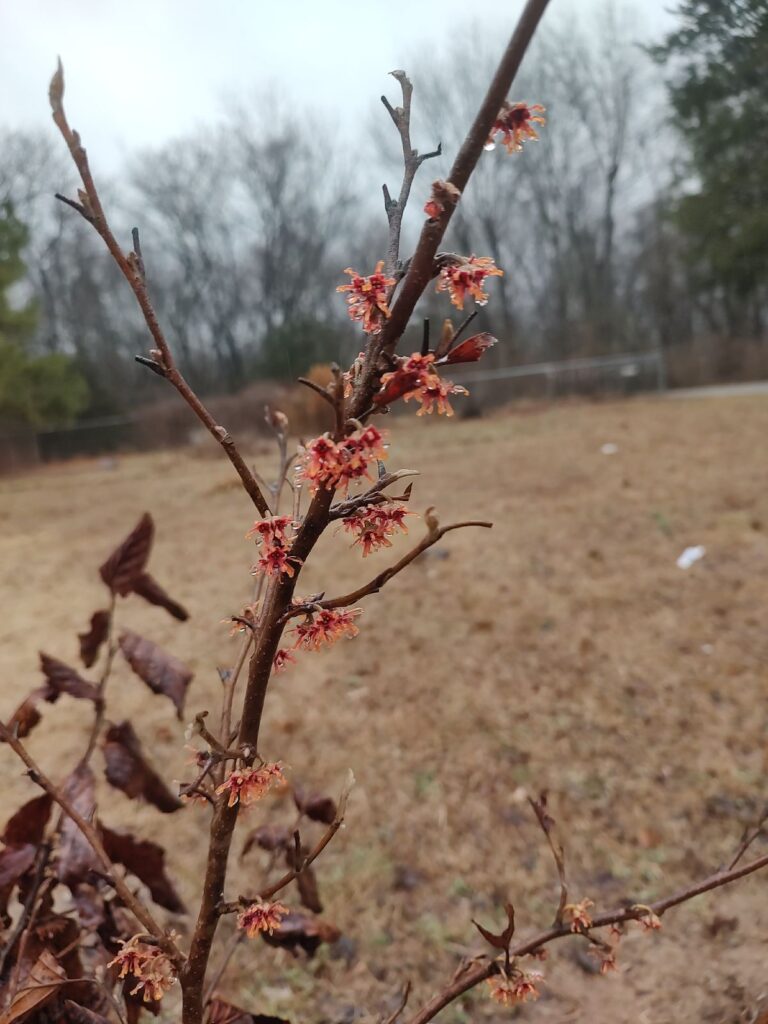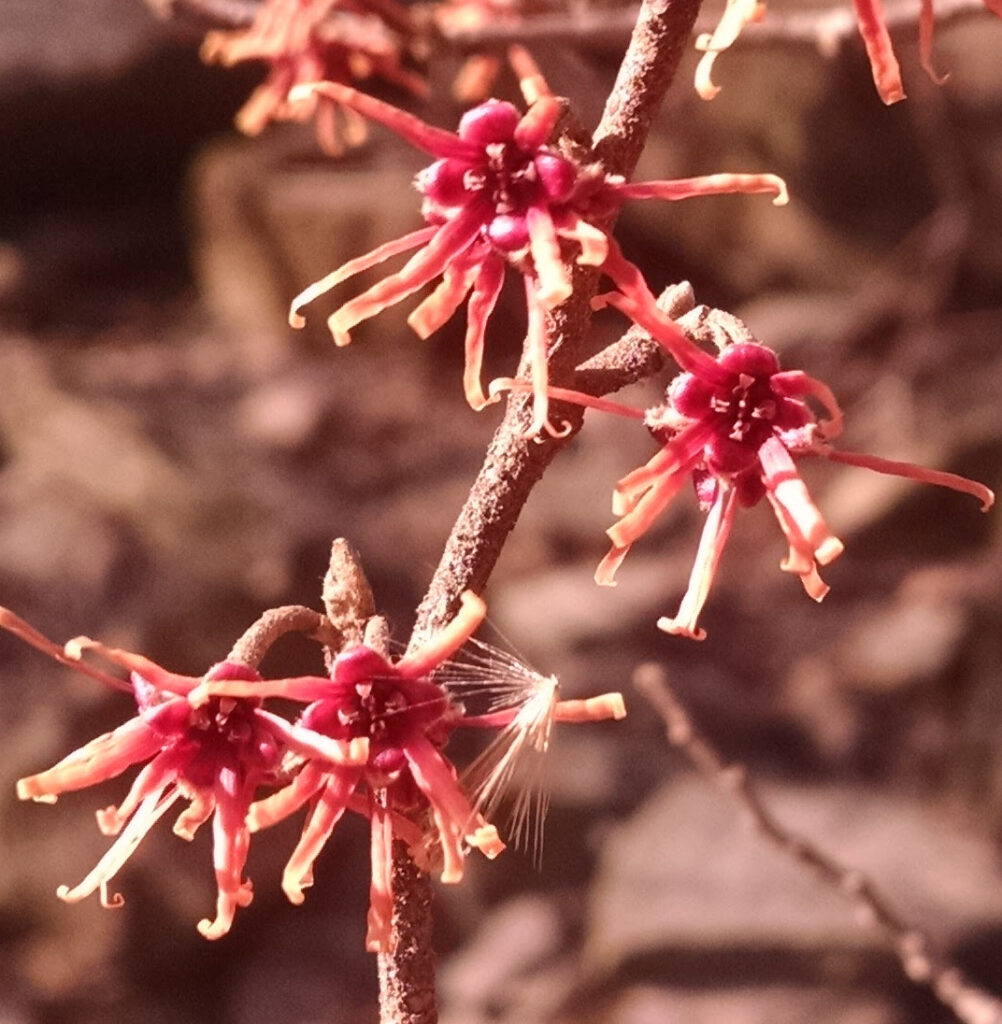By Roslyn Imrie.
Winter may not be the most popular season, but it is my favorite time to walk in the woods. Only in winter can you be relatively sure that you won’t get bitten by ticks, infested with chiggers, or attacked by mosquitoes while walking through the hills. During most of the year, the dense Ozark foliage blocks anyone’s view, reserving hilltop vistas only for cliffs and rocky outcroppings, but in winter one can peer through the bare trees and see the vistas beyond. For this same reason, it is easier to spot wildlife for they have much less cover to hide among. The Ozarks may not be teeming with life, but birds can be spotted nesting in trees and deer can be watched bounding through the forest. And though there are not gnats buzzing around your eyes, mosquitoes humming in your ears, or flies landing on your arms reminding you that the Ozarks are full of life, these hills and hollows are far from dead. In the dead of winter, when trees are naked, frost laces the grass, and most living creatures are hibernating, the Witch Hazel blooms.

It is called Witch Hazel because it has a long history of being the choice tool in dowsing or witching for water among early settlers. Dowsers select forked branches that are both bendable and grow near water to look for water underground so that wells can be dug with certainty. Whether or not you believe in witching for water, the shrub’s medicinal properties are undeniable.
You probably have Witch Hazel products in your bathroom. It has been used for hundreds of years and is still widely used today in all sorts of pharmaceutical products. Its leaves and bark have strong astringent properties and the plant is used in face cream, various skin remedies, and hemorrhoid medicine. Witch Hazel is good for just about every skin ailment from scrapes and bruises, to insect bites and rashes. It makes a good aftershave, soothes a sunburn, and clears up acne too. In the past, Native Americans and early settlers used its twigs to make teas that aid in diarrhea, cholera, colds, and asthma.
In nature, the shrub-like tree often grows along river banks, where it can dip its roots into the water, but it can be found elsewhere along moist hillsides throughout the woods. The seeds develop in pods that explode with a loud pop and shoot the seed 20 or 30 feet, dispersing them. There are two varieties of Witch Hazel to be found in this area, but both are large shrubs that can grow from 10 to 12 feet tall with a wide 8-foot spread. The Ozark Witch Hazel (Hamamelis vernalis) is endemic to the Ozark Plateau (meaning it grows nowhere else in the world) and blooms yellow and red flowers throughout February and March. The American Witch Hazel (Hamamelis virginiana) usually blooms with lighter yellow flowers in December or January. The blooms on the plant survive harsh winter temperatures by rolling up their petals. On sunny days, they unfold and their fragrance is remarkable. It is quite a sight to see a shrub covered in wispy blossoms on a sunny January day.
Most plants that depend on pollination for reproduction choose spring or fall or even summer to bloom because it is during these warm seasons that the Ozarks is overflowing with life, but not the Witch Hazel. When the forest seems dead, it opens its yellow wispy petals, fills the forest with fragrance, and waits for a pollinator.
But what pollinator is flying about in winter? By day there are some gnats still living that might pollinate the Witch Hazel. These tiny gnats use chemicals in their body to make a sort of antifreeze that keeps their bodies from freezing when the temperature drops. Many creatures such as frogs and toads also use antifreeze to keep themselves from freezing solid in winter, but it is less common for a creature using this survival tactic to be active, feeding, and pollinating flowers during the coldest time of the year. Most likely, this gnat, as well as other observed daytime pollinators, are not necessarily frequent visitors, but instead emerge on warmer days by mistake, thinking spring has arrived.

The little bursting flowers are most efficiently pollinated by night when a little owlet moth visits them. A few species of owlet moths thrive in the winter. They stay warm by shivering to raise their body temperature. Unlike humans, who are not particularly efficient at shivering, the winter moth can raise its body temperature 50 degrees. When flying, the moth loses body heat rapidly, so on long journeys it must stop and shiver to keep its body temperature up to the 86 degrees necessary for flight.
A shivering moth may seem almost as silly as a winter flower, but they have found a biological niche. Just think of all the advantages to being a rare winter species. The bats, who eat moths, are hibernating, and many of the birds who eat flies have migrated south. So perhaps like its pollinating counterparts, the flowering Witch Hazel is taking advantage of the barren winter landscape to bloom and get pollinated when no predators are afoot.
So when the sun peeks out at high noon on a warmer than usual winter day, take a walk in the Ozarks. Experience the vistas only seen when all the leaves have fallen. Watch the birds in the trees and the water tumbling over rocks in an icy stream. And if you are lucky, you may stumble upon a tree in full bloom, just waiting for a lost insect or a winter moth to visit its fragrant flowers.
